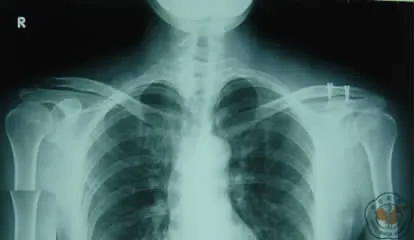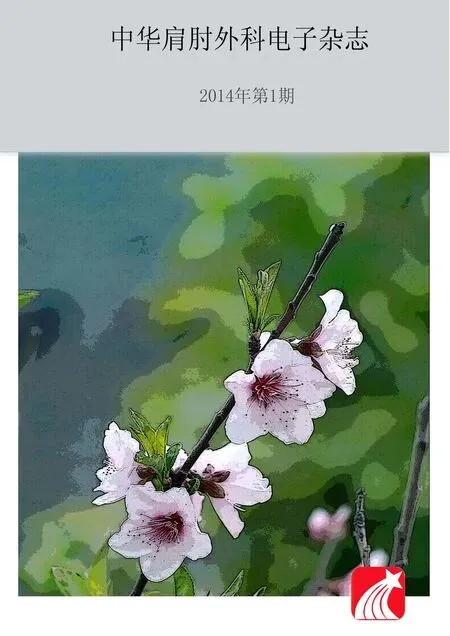应用LARS人工韧带治疗急性肩锁关节脱位的初步报告
陈爱民 鹿楠 叶添文 杨鹏 朱磊 李菁
应用LARS人工韧带治疗急性肩锁关节脱位的初步报告
陈爱民 鹿楠 叶添文 杨鹏 朱磊 李菁
目的评价通过LARS人工韧带重建并加强喙锁韧带的方法治疗肩锁关节脱位的临床效果。方法应用LARS人工韧带重建喙锁韧带治疗8例TossyⅢ型肩锁关节脱位,其中男性5例,女性3例;年龄21~45岁;左肩3例,右肩5例。致伤原因:摔倒7例,车祸1例。临床评价采用Constant评分和VAS评分。采用双侧肩锁关节的Zanca位片和患侧肩关节腋位片进行影像学评价。结果所有患者获得平均24(5~40)个月的随访。8例肩锁关节脱位均获得复位,肩关节Constant评分从术前的(59.3±6.9)分提高到(96.5±9.3)分(t=300,P <0.05)。VAS评分从术前的(5.4±1.3)分下降到(0.7±0.9)分(t=300,P <0.05)。术后X线片显示7例患者获得了解剖复位,有1例复位轻度丢失。发现2例喙锁韧带钙化,1例肩锁关节退变,未发现挤压螺钉周围骨溶解。结论应用LARS人工韧带进行喙锁韧带重建可以为肩锁关节提供可靠的初期强度,并允许患者早期进行功能锻炼,可以使患者得到较好的临床疗效,而且并发症少。
肩锁关节; 脱位; 喙锁固定; LARS人工韧带
目前,临床上对于手术治疗TossyⅢ型肩锁关节脱位的看法比较一致[1]。由于损伤后维系关节稳定的喙肩韧带和喙锁韧带断裂,受上肢重力和胸锁乳突肌等作用,锁骨向后、向上移位,上肢和肩胛骨下沉移位。保守治疗易出现诸如复位困难、外固定后再脱位以及引发皮肤压迫性溃疡等并发症,故对Ⅲ型肩锁关节脱位多倾向于手术治疗。由于韧带的修复只能靠瘢痕修复,单纯修复并固定喙锁韧带有可能在去除内固定后发生再次脱位。因此,本研究采用重建喙锁韧带的手术方法治疗TossyⅢ型肩锁关节脱位。
资料与方法
一、一般资料
自2006年11月至2009年7月,我院共收治了8例TossyⅢ型肩锁关节脱位患者,均为急性病例,其中男性5例,女性3例;年龄21~45岁;左肩3例,右肩5例;摔倒7例,车祸1例。应用LARS人工韧带重建喙锁韧带的治疗方法。
二、治疗方法
所有患者均为单纯肩锁关节的TossyⅢ型脱位,不伴有其他部位的创伤和皮肤破损。入院后,完善常规的术前检查和评估,采用LARS人工韧带进行重建喙锁稳定结构治疗。所有患者的手术均在伤后2~5d内在全麻下进行,手术时间60~90min。
麻醉成功后,取沙滩椅位,患者仰卧位,患侧肩部垫高。所有患者均在术前通过锁骨长度估计斜方韧带和锥状韧带的附丽点。切口沿患侧肩峰、锁骨远端弧形向前下至喙突,显露锁骨、喙突尖。找出断裂的喙锁韧带,然后用可吸收线褥式缝合喙锁韧带,预留线不打结。然后再次确定喙锁韧带的附丽点在冠状面上的位置,有条件的可以在术中通过喙锁韧带的显露来确定,用直径4.5mm的钻头各钻一个孔,钻孔位置在保证强度的前提下,应在矢状面上尽量靠前方。用通过导向器将LARS人工韧带穿过喙突根部,从LARS人工韧带的两端分别穿过锁骨骨隧道,确认整复达到满意复位后,收紧人工韧带,挤压螺钉固定,编织打结韧带两侧,用不可吸收线缝合,剪除多余部分。将修复喙锁韧带上的可吸收缝线拉紧并打结。
术后给予常规的抗感染等处理,三角巾悬吊患肢。术后即嘱患者行手指和前臂功能活动,3d后可以开始行肩关节主动活动,3周后患者可以去除三角巾,进行日常活动,3个月内禁止剧烈活动。
临床评价采用Constant评分和VAS评分,对术前、术后的评分进行秩和检验,以P<0.05为差异有统计学意义。采用双侧肩锁关节的Zanca位片和患侧肩关节腋位片进行影像学评价(图1)。

图1 术后双侧对比X线片
结 果
所有患者随访5~40个月。患侧肩关节的Constant评分由术前的(59.3±6.9)分提高到术后的(96.5±9.3)分(t=300,P <0.05),VAS评分由术前的(5.4±1.3)分下降到(0.7±0.9)分(t=300,P<0.05)。肩锁关节的双侧Zanca位片显示7例患者均获得了完全的解剖复位,1例患者有轻度的复位丢失。没有患者发生再次脱位。发现2例喙锁韧带钙化,1例肩锁关节退变,未发现挤压螺钉周围骨溶解。所有患者在轴位片上未见到锁骨远端在水平方向上的移位,未发现螺钉退出、锁骨骨折或喙突骨折。
讨 论
肩锁关节是一个不典型的球窝关节,其运动中心位于肩锁关节和喙锁韧带之间。锁骨外端稳定的主要因素是喙锁韧带的固定作用。肩锁关节的这种解剖性质决定了肩锁关节脱位损伤修复最佳的办法就是重建喙锁韧带,如果未能重建喙锁韧带,即使将肩锁关节复位,在固定物取出后,仍然可能发生再脱位[23]。以往的手术方法主要原理是在固定肩锁关节的同时修复喙锁韧带。但是单纯修复韧带,愈合率较低,且韧带初期愈合的疤痕组织难以承受早期功能锻炼所需要承受的张力[4-6]。因此,患者在经历了漫长的恢复过程后,都存在不同程度的功能丧失[7],延后了患者作为一名正常人重返社会的时间。后来,有学者开始应用韧带重建的方法来实施手术[8]。重建韧带的材料早期主要来源于自体取材和异体移植。自体取材的移植物要经过坏死-再血管化-细胞增殖-韧带化的过程,该过程约需一年的时间。因此早期必须适当限制患者的活动,这与早期锻炼,尽量减少功能丧失的初衷是不符合的。后期自体移植物容易出现松弛,抗拉力下降,最终仍难避免出现骨性关节炎。随着材料技术的进步,我们开始应用人工韧带进行修复重建手术。相比于自体和异体组织,人工韧带有着明显的优势:(1)创伤小:由于手术不需要从自己身体上取材,减少了创伤;(2)恢复快:人工韧带具有一定的力学强度,不需要在人体内进行坏死-再血管化-细胞增殖-韧带化的过程。因此,缩短了恢复时间,节省了医疗资源和社会成本。
我们采用法国LARS聚酯纤维支架型韧带作为本研究的手术材料。这种韧带具有以下特点:(1)具有较高的生物相容性:PET聚酯纤维与缝线和人造血管相同,生物相容性好,其内部的自由纤维适合引导人体本身的纤维结缔组织长入;(2)通过了“拉力-弯曲-扭转”混合测试:可以承受5 000牛顿的拉力;(3)术中可以保存韧带残余组织,保持生理本体感受。以上几点可以看出:我们所采用的韧带是一种永久-支架型韧带,组织相容性好,能够提供很好的抗拉力。其纤维内30~50μm微孔适合组织的长入,可以起到“支架”的作用,引导自身结缔组织长入,不仅起到了物理修复的作用,亦能起到生物组织工程修复的作用。这种韧带在早期可以提供较好的初期强度,能够承受患者进行早期功能锻炼所需要的强度;在后期,随着自体组织的长入和修复,最终强度能够得到保证。这种修复方法是一种生理性重建,对于陈旧性的脱位也可以采用。因此,永久-支架型人工韧带是一种治疗肩锁关节脱位尤其是陈旧性脱位的有效治疗方法。韧带重建手术的关键是如何确定在锁骨上钻孔的位置和方向。既然是重建韧带,我们认为:沿着原有韧带走行方向是最符合生理的,也能最大限度的保证人体组织长入人工韧带,以达到生理性的重建。此种人工韧带也有其局限性。首先,它的价格比较昂贵,在我国现有国情下限制了其广泛的应用;其次,韧带的固定大部分要靠挤压螺钉,对于骨质疏松的患者不太适合;再次,人工韧带的应用目的是最大限度的恢复患者的术前功能,对于术前功能已有丧失和对功能要求不高的患者来说,人工韧带并不是最适合他们的方法。
本研究认为,LARS人工韧带重建喙锁韧带技术是治疗肩锁关节脱位的一个可行的方法。此种韧带可以提供可靠的初期强度,为喙锁韧带的一期愈合提供了较好的生物力学环境,其支架型韧带可为后期修复体强度的维持提供可靠的保证。另外,人工韧带无需二次手术取出内固定,减少了患者的痛苦和经济负担。
[1] 任逸众,刘晓民.肩锁关节脱位的手术治疗[J].中华创伤骨科杂志,2006,8(2):176-177.
[2] Constant CR,Murley AH.A clinical method of functional assessment of the shoulder[J].Clin Orthop Relat Res,1987,(214):160-164.
[3] Tiren D,van Bemmel AJ,Swank DJ,et al.Hook plate fixation of acute displaced lateral clavicle fractures:mid-term results and a brief literature overview[DB/OL].J Orthop Surg Res,[2012-01-11].http://www.ncbi.nlm.nih.gov/pubmed/?term=PMC3313877.
[4] Clavenger T,Vance RE,Bachus KN,et al.Biomechanical comparison of acromioclavicular joint reconstructions using coracoclavicular tendon grafts with and without coracoacromial ligament transfer[J].Arthroscopy,2011,27(1):24-30.
[5] Cohen G,Boyer P,Pujol N,et al.Endoscopically assisted reconstruction of acute acromioclavicular joint dislocation using a synthetic ligament.Outcomes at 12months[J].Orthop Traumatol Surg Res,2011,97(2):145-151.
[6] 马少云,曹建斌,方汉民,等.3种内固定加喙锁韧带重建Ⅲ型肩锁关节脱位的效果比较[J].中国临床解剖学杂志,2005,23(2):211-214.
[7] Liu ZT,Zhang XL,Jiang Y,et al.Four-strand hamstring tendon autograft versus LARS artificial ligament for anterior cruciate ligament reconstruction[J].Int Orthop,2010,34(1):45-49.
[8] Milewski MD,Tompkins M,Giugale JM,et al.Complications related to anatomic reconstruction of the coracoclavicular ligaments[J].Am J Sports Med,2012,40(7):1628-1634.
The treatment of the acute acromioclavicular joint dislocation with LARS artificial ligament:apreliminary report
Chen Aimin,Lu Nan,Ye Tianwen,Yang Peng,Zhu Lei,Li Jing.Department of Orthopedic,Changzheng Hospital Affiliated to Second Military Medical University,Shanghai 200003,China
BackgroundCurrently,the clinical perspectives of surgical treatment for Tossy Ⅲacromioclavicular(AC)joint dislocations are relatively identical.Due to the post-traumatic ruptures of the acromioclavicular ligament and coracoclavicular(CC)ligament which are used to maintain stability of the joint,the clavicle moves backward and upward,and the upper arm and the scapula drops downward for the gravity of the upper arm and the influence of the sternocleidomastoid muscle.Since such complications as reduction difficulties,redislocation after external fixation,pressure ulcers of the skin,and so forth are particularly prone to occur in the conservative therapy,the operative treatment is more inclined to be adopted for the Tossy Ⅲ dislocation of the AC joint.With the single repair and fixation of the CC ligament,redislocation is likely to happen after implant removal because the ruptured ligaments healed as scar tissue.Therefore,this study uses an operative method of reconstructing and augmenting the CC ligament with LARS artificial ligament for the treatment of TossyⅢ AC joint dislocation,and evaluates its clinical effect.MethodsFrom November 2006to July 2009,8patients with acute AC joint dislocation of Tossy Ⅲ were admitted into our hospital.Five patients were male and 3were female,and their ages ranged from 21to 45.Sides:3injuries were on the left and 5were on the right.Seven patients suffered from falling on the ground,and 1patient was injured in a traffic accident.All the patients were treated with LARS artificial ligaments to reconstruct the CC ligament.Constant score and VAS score were adopted in clinical evaluation.Zanca view of the bilateral AC joint and the axillary radiograph of the affected shoulder joint were employed for imaging evaluation.All the patients were simple TossyⅢ dislocation of AC joint with no trauma of other partsand skin breakdown.Regular pre-operative examinations and evaluations were carried out after admission,and LARS artificial ligament was used to reconstruct the CC ligament.Surgeries of all the patients were performed under general anesthesia within 2to 5days after injury,and the operation time ranged from 60to 90minutes.After successful anesthesia,the patient lied on a beach chair position with the affected shoulder bolstered up.Attachment points of trapezoid ligament and conoid ligament are evaluated preoperatively through the length of clavicle among all the patients.The incision is made along the affected acromion and distal clavicle,curved downward to expose the clavicle and the tip of coracoid process.Find the ruptured CC ligament and then repair it with absorbable stiches by mattresssuture,leaving the reserved sutures unknotted.Then reconfirm the attachment point of CC ligament is on the location of coronal section,and if possible,the location can be identified by the exposure of CC ligament.Drill a hole separately with a diameter of 4.5mm bit,and make sure that the drilling position is in the sagittal plane close to the front on the premise of intensity.Make the LARS artificial ligament pass through the root of coracoid with a drilling guide,and thread the two ends of ligament through the clavicular bone tunnel.After the confirmation of satisfactory reduction,tighten up the artificial ligament and fix the interference screws.Weave and knot the two sides of the ligament,suture with nonabsorbent stitches and cut off the redundant part.Strain the absorbable suture on CC ligament and tie a knot.The routine anti-infection treatments were given and the affected arm was slung with scarf bandage.The patient was told to carry out functional activities of fingers and the forearm postoperatively.Active mobilization of the shoulder was initiated after 3days and regular movements were in process without scarf bandage 3weeks later.Such strenuous activities as physical exercise were forbidden within 3months.Constant score and VAS score were adopted in clinical evaluation.Zanca view of the bilateral AC joint and the axillary radiograph of the affected shoulder joint were employed for imaging evaluation.ResultsAll the patients were followed up for 5to 40months.Constant score of the affected arm increased from (59.3±6.9)preoperatively to(96.5±9.3)postoperatively(T =300,P <0.05),and VAS score decreased from (5.4±1.3)preoperatively to(0.7±0.9)postoperatively(T=300,P <0.05).Zanca view of the bilateral AC joint revealed that 7patients had an anatomical reduction,except for one patient with slight loss of reduction.No re-dislocation occurred.Two cases of CC ligament calcification and one case of AC joint degeneration were found,and no osteolysis around the interference screw was detected.No shift of the distal clavicle in the horizontal direction was found in the axial view,and neither was backing out of the screws,the clavicular fracture,or the coracoid fracture.Discussion AC joint is a non-typical ball-and-socket joint,the center of which is located between the AC joint and the CC ligament.The stability of the distal clavicle mainly depends on the integrity of CC ligament.The optimal method for dislocation of the AC joint is to reconstruct the CC ligament,which is decided by the anatomical characters of the AC joint.Otherwise,redislocation might still occur after the removal of the internal fixator even if the AC joint is reduced.Previous primary principle of the operation method was the repair of CC ligament with the fixation of AC joint at the same time.However,single repair of the ligament had a low healing rate,and the scar tissue of the ligament hardly bore the tension required for the early functional exercise.Hence,after a long period of recovery procedure,patients suffered from different degrees of functional incapacitation,which postponed their schedule of returning to work.Some scholars afterwards started using the method of ligament reconstruction to perform the surgery.Autografts and allografts are sources for ligament reconstruction.The process of necrosis,revascularization,cell multiplication,and ligamentization is needed for autogenous grafts,which will take around 1year.Therefore,proper limitation of patient’s early activities is inconsistent with our original intentions of early training to reduce the loss of function.Laxity of grafts is likely to be observed during the late period with decreased stretching resistance,and still has difficulty in avoiding osteoarthritis eventually.With the development of the material technology subsequently,we start the operation of repair and reconstruction with the application of artificial ligament.Compared to autologous and allogeneic grafts,artificial ligament has obvious advantages:(1)Less injury:The trauma is decreased since there is no need for the surgery toharvest tendons from his or her own body.(2)Quick recovery:Artificial ligament has a certain degree of the mechanical strength without necessities of the process of necrosis,revascularization,cell multiplication,and ligamentization inside the body.Accordingly,the application of artificial ligaments shortens the recovery time with less medical resources and society costs.We adopt the French LARS polyester fiber ligament of bracket type as our surgical materials for this study.This kind of ligaments has features as follows:(1)Higher biocompatibility:The PET polyester fiber is identical with sutures and artificial blood vessels and has excellent biocompatibility,the free fiber inside which can induce the ingrowth of fibrous connective tissue of the human body itself.(2)Pass the“tension-bending-torsion”hybrid test:It may bear the pulling force of 5000Newton.(3)Preserve the intraoperative remnant tissue of the ligament and keep the physiological proprioception.From the points above we can see that:The permanent-stent ligament we adopt had good histocompatibility and can provide excellent tensile resistance.The micropores of 30~50μm inside the fibers are suitable for the ingrowth of the autologous connective tissue,and can play the role of“support”,not only as physical remediation,but also with the function of the biological tissue engineering repair.This ligament can provide better early strength in the initial stage,and is able to withstand the intensity required by patients’early functional training.The ultimate intensity will be ensured with the ingrowth and restoration of the autologous tissue in the late stage.The restorative procedure is a kind of physiological reconstruction,which can also be applied for obsolete dislocations.Hence,the permanent-scaffold ligament is an effective method for the treatment of AC joint dislocations,especially the old dislocation.The key issue of the ligament reconstruction is how to determine the location and direction of drilling on the clavicle.Since it is ligament reconstruction,we consider that it is the most consistent with physiological features as the prosthetic ligament travels along the walking direction of the original one,which can maximally guarantee the ingrowth of the human tissue into the artificial ligament to achieve its physiological reconstruction.This prosthetic ligament has limitations as well.First,it is expensive,which restricts its extensive application in the current situation of China.Second,fixation of the ligament mainly relies on interference screws,and it is not suitable for the patients with osteoporosis.Once again,the objective of the use of artificial ligaments is to restore patients’preoperative function to the maximum extent.Therefore,artificial ligament is not most suitable for patients who have the loss of preoperative function or patients with not-so-high requirement for function.We consider that the technology of CC ligament reconstruction with LARS artificial ligament is a feasible method in the treatment of the AC joint dislocation.Such ligament can offer credible strength in the early period,which provides a preferable biomechanical environment for the primary healing of the CC ligament,and the merits of the ligament of bracket type reliably assure the preservation of the repair strength in the late stage.In addition,the advantage of artificial ligaments is unnecessary to remove implant by a second surgery,which decreases the patient suffering and financial burdens.Conclusions CC ligament reconstruction with the LARS artificial ligament can offer reliable early strength for AC joint,and it allows early functional training of patients.This enables patients to acquire better clinical outcome and less complication.
Dislocation of acromioclavicular joint; Tossy Ⅲ; Artificial ligaments;Reconstruction
Chen Aimin,Email:aiminchen@aliyun.com
2013-12-20)
(本文编辑:李静)
10.3877/cma.j.issn.2095-5790.2014.01.005
200003 上海,第二军医大学附属长征医院骨科
陈爱民,Email:aiminchen@aliyun.com
陈爱民,鹿楠,叶添文,等.应用LARS人工韧带治疗急性肩锁关节脱位的初步报告[J/CD].中华肩肘外科电子杂志,2014,2(1):23-27.

